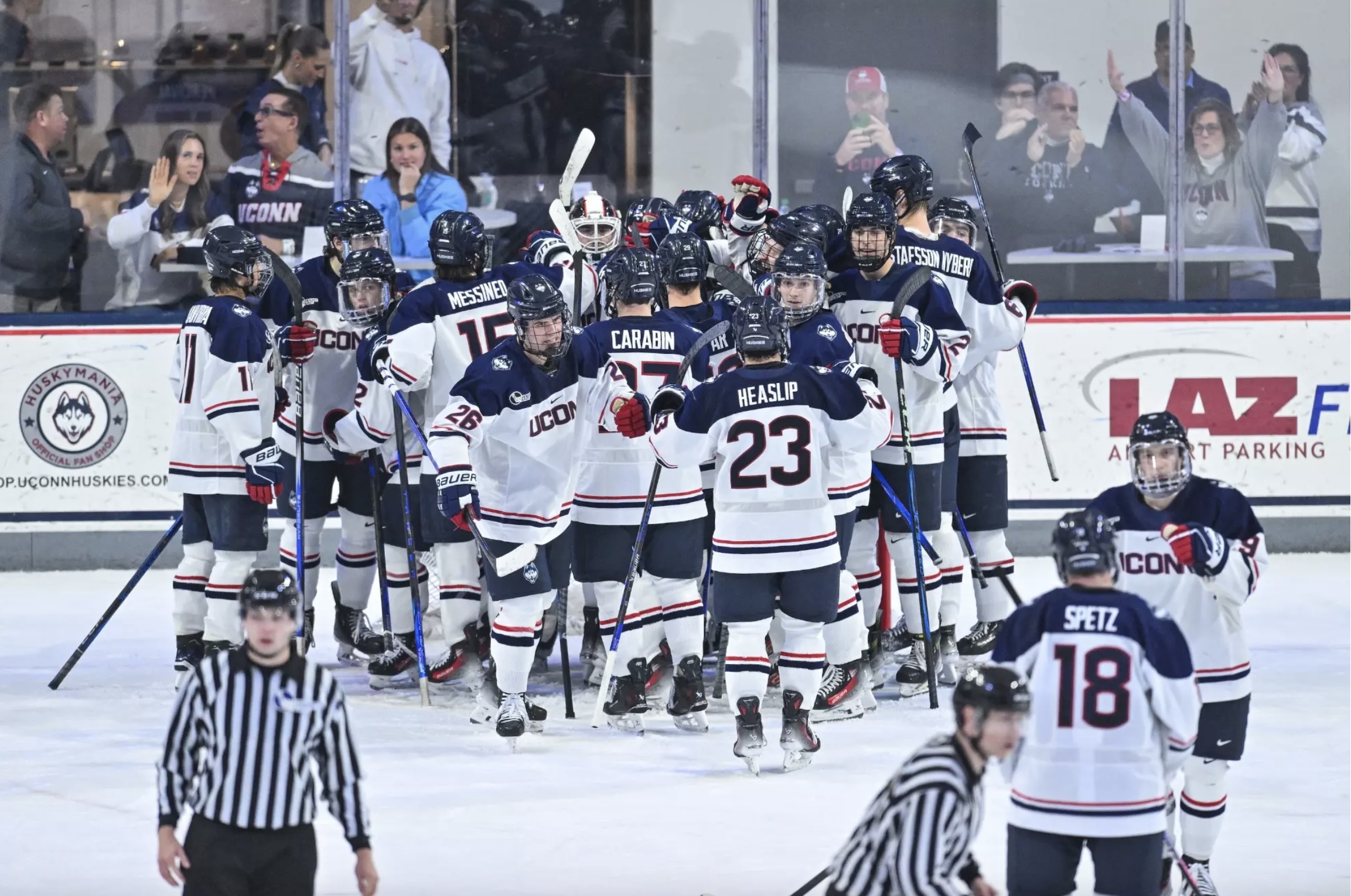UConn on the brink of history with surprising rise

HARTFORD, Connecticut — The number of people who saw this coming likely doesn’t stretch too far into the triple digits.
Outside of the players in the UConn dressing room, the coaching staff, and a few dozen more, the idea that the Huskies could be a top-five team in the country would have been seen as far-fetched at best. They finished 15-19-2 last season, and at the start of this year, most pundits had them well outside NCAA tournament contention. The preseason Hockey East coaches' and media polls both ranked them eighth out of 11.
And who could blame them? On top of coming off a sub-.500 season, the Huskies were rocked by transfers in the summer, with three drafted players opting to take their talents elsewhere. And these weren't fringe contributors, either: talented sniper Matthew Wood (2023 Nashville first rounder) went to Minnesota, excellent two-way forward Samu Salminen (2021 Devils third rounder) went to Denver, and No. 1a goaltender Arsenii Sergeev (2021 Flames seventh rounder) went to Penn State.
UConn coach Mike Cavanaugh, now in his 12th year with the program, has talked a lot this season about the extremely high quality of the leadership group in their room this season, in a way that most coaches do not. A lot of the players who stuck around and didn't transfer when they could have — grad students like Hudson Schandor, whom Cavanaugh has called "the epitome of a UConn player," or John Spetz, and upper classmen like Jake Percival or Ryan Tattle — kind of rallied around the idea that it takes a certain kind of player to not only succeed in Storrs, but also drive the program forward.
In a hyper-competitive league like Hockey East, where the top teams are among the very best in the country, UConn was always going to be a handful because of how they play the game—but they weren’t expected to be especially dangerous.
Four months later, everyone is singing a very different tune. The Huskies are 14-9-3, with a plus-13 goal differential and a plus-57 shot differential. They are simply very good and currently sit sixth in the PairWise rankings. As of now, they have a 98 percent chance of making the NCAA tournament, according to PlayoffStatus.com, so unless things go unimaginably badly in February and March—we’re talking "only if they don’t win another game for the rest of the season" territory—the Huskies seem poised to make the NCAA tournament for the first time in program history, and it won’t be any kind of fluke.
While they were sub-.500 last season for a litany of reasons, they appear to be on the verge of hitting 20 regular-season wins for the third time in four years, unless something goes very wrong.
That said, the Huskies didn’t get off to the greatest start this season, going 7-7-1 in the first half of the year with 41 goals against in 15 games, but they occasionally flashed the potential they’ve now exhibited regularly since returning from the holiday break.
In many ways, the turning point of the season dates back to early November, when UConn was swept by Merrimack. They had played only one truly good team to that point (a road loss to BU) but were sitting at .500 and facing a tough road ahead, with a string of nationally ranked opponents on the schedule and a stretch with just two home dates in their next 14 games.
“When you play 34 games, you have a long season here in this league,” Cavanaugh told Elite Prospects.
“Sometimes you’re flat some weekends. But certainly, that was something that I think galvanized our group and said, ‘Hey, we don’t want to get swept on weekends.’”
Maybe it was a quirk of the schedule, or maybe that leadership and will simply coalesced into more tangible results. Because something funny and unexpected happened immediately after that Merrimack series: the Huskies beat No. 1 Boston College and No. 11 UMass Lowell in back-to-back games, then lost a pair of one-goal decisions to those same teams. Since that overtime loss to BC on the road on Dec. 4, they’ve reeled off a 7-2-2 record, with wins over nationally ranked opponents like UNH (whom they swept), Maine (a win and a tie in Orono), and Quinnipiac (for the first time in eight years). They also tied Providence College on the road before dropping the back half of the home-and-home in front of a school-record crowd of nearly 12,000 fans in Hartford this past weekend.
Not the results they wanted, but even the loss was encouraging. They started slow, fell behind 3-0 early in the second period, then tied the game before a late, ill-advised penalty did them in. Nonetheless, they’ve shown repeatedly that they can do more than just hang with the best teams in the country—and even the losses don’t hurt quite so badly.
“We have a really good hockey team, and we can either learn from this—and I think we will,” Cavanaugh said.
One thing they will need to bounce back from a not-as-good-as-they-wanted weekend against a borderline-elite opponent is continued production at the top of the lineup, which has mostly come from two players: Tattle and Joey Muldowney. The two have combined to score 27 of UConn's 79 total goals, despite entering the season with a total of nine in 82. They've been given more minutes in more high-leverage situations, and the fact that they really only share power-play time in a lot of situations helps UConn spread out the offense a little more than they've been able to in the past.
"They were playing together quite a bit, they were playing great hockey last year, so it's not like it just came on in the scene this year," Cavanaugh said. "They just kind of built on what they did last year. … I think they're getting a lot more opportunities, probably, now.
And yeah, they're playing the game the right way. When you play the game in the right way, the hockey gods reward you."
Another aspect of the UConn offense that cannot be overlooked is that their penalty kill is a huge source of goals for them. They lead the country with eight shorties this year — Tattle has three of them, tied for the national lead, Percival and Tabor Heaslip have two apiece, and Schandor has one — while allowing just 16 power-play goals. More than 1 in every 10 goals they've scored to date comes on the PK.
"A lot of teams are in a 1-3-1, so they have two guys on the flanks," Cavanaugh said after a recent win over UNH. "When the puck turns over, our guys go, and that's how it creates a lot of 2-on-1s. They're flat-footed and we get going, and we skate well."
The UConn PK is 18th in the country overall (82.8 percent), but the fact that they are only minus-8 when down one or two men tells you a lot about the statistical drivers of their success. Only a handful of teams have better shorthanded goal differences, and they're mostly top teams, including Boston College (minus-2) and Western Michigan (minus-3).
Another crucial part of both penalty-kill and 5-on-5 play, of course, is goaltending, and that was a huge question mark for UConn coming into the season. With Sergeev departing and Ethan Haider graduating, the Huskies were forced to go with three relatively unknown quantities: junior transfer Tyler Muszelik, plus freshmen Callum Tung and Thomas Heaney. What was a big "if" quickly became a big positive; UConn is tied for 19th in team save percentage (.911) despite injuries forcing them to use Heaney, who wasn't really expected to play much this season, against brand-name programs BU, BC, and Wisconsin, and he held his own.
But Muszelik (.916 in 16 appearances, after two sub-.890 years at UNH) and Tung (.934 in eight) have been carrying the banner all season, with very few nights off. Cavanaugh credits goaltending coach Vince Stalletti with getting both goaltenders on the team's radar.
“I didn’t even know who Callum was, and he brought him up to me and said, ‘This is a kid we have to get,’ and he pushed for him,” Cavanaugh said. “And then when Ty went into the transfer portal, he said, ‘I really like his game. I think there’s a lot there.’ So I trust him, he does a great job with them, and goaltending has certainly been pretty solid for us this year.”
One of the things Cavanaugh has preached to his team all season is consistency, and they’ve mostly delivered. Apart from the no-show first period against Providence on Saturday, the fact that they battled back from a 3-0 deficit still stands out as a positive. You’re not going to win every game, no matter how good you are—it’s more about the response to those losses. In this conference, the road ahead doesn’t get much easier—the Huskies still have games against UMass Lowell, Maine, and BU on the schedule—but based on the maturity of the group and the fact that they’ve only lost more than one in a row all season, it’s reasonable to expect they’ll continue to find success.
It’s a little bit new for this program, which has broken 20 wins a couple of times in recent seasons and once reached the Hockey East championship game. But maybe the time for celebrating nice seasons is over. Maybe it’s finally time to start celebrating conference and national achievements.
This season has been a big surprise, but as they keep building on their past successes, no one will be shocked if they continue to do it year after year.
